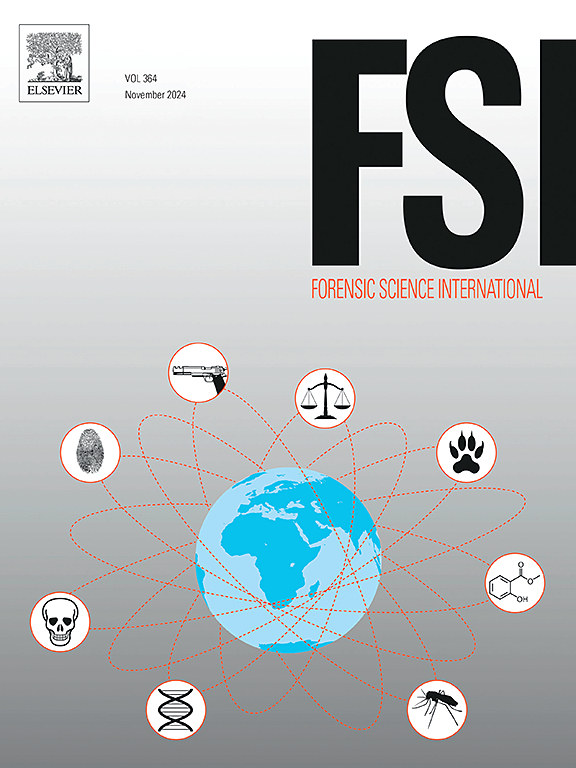技术说明:Pöch面部形状分类系统的可靠性:一种形态计量学方法
IF 2.5
3区 医学
Q1 MEDICINE, LEGAL
引用次数: 0
摘要
在法医人类学中,面部特征的标准化词汇对于识别活着的和死去的个体都是必不可少的。Pöch的面部形状分类系统被广泛用于此目的,但其可靠性尚未得到严格评估。这一点尤其重要,因为该系统最初是基于欧洲男性人群开发的,先前的研究表明,分类系统可能容易出现观察者不一致的情况。在这项研究中,我们评估了Pöch系统在描述墨西哥样本中脸型变化的代表性和可靠性(n = 973)。首先,使用几何形态计量学和主成分分析,我们评估了系统的类别捕获观察到的面部多样性的程度。然后,16名观察者使用Pöch的系统对60张随机选择的面孔进行两次分类,我们计算了Fleiss的Kappa和Cohen的Kappa来评估观察者内部和内部的一致性。观察者之间的一致程度也通过计算每种面部形状的一致比例来衡量。我们的研究结果显示,在Pöch的大多数类别中存在显著的形态冗余,观察者内部(平均Cohen ' s Kappa = 0.203)和观察者之间(平均Fleiss ' Kappa = 0.112)的一致性较差,只有圆形和椭圆形类别表现出高度的一致性。鉴于该系统的性能较差,我们对Procrustes坐标进行了事后k-均值聚类分析,以探索更具代表性的分类方案。由此得出的四种脸型分类可以为更有代表性和更可靠的分类系统的发展提供信息。本文章由计算机程序翻译,如有差异,请以英文原文为准。
Technical Note: Reliability of Pöch’s facial shape classification system: A morphometric approach
A standardized vocabulary of facial characteristics is essential in forensic anthropology for identifying both living and deceased individuals. Pöch’s facial shape classification system is widely used for this purpose, but its reliability has not been critically evaluated. This is particularly important as the system was originally developed based on European male populations, and prior research suggests that classification systems can be prone to observer inconsistencies. In this study, we evaluate the representativeness and reliability of Pöch’s system in describing face shape variation within a Mexican sample (n = 973). First, using geometric morphometrics and principal component analysis, we evaluated how well the system’s categories capture the observed facial diversity. Sixteen observers then classified 60 randomly selected faces twice using Pöch’s system, and we computed Fleiss’ Kappa and Cohen’s Kappa to assess intra- and inter-observer agreement. The level of consensus among observers was also measured by calculating the proportion of agreement for each facial shape. Our findings revealed significant morphological redundancy among most of Pöch’s categories, poor agreement within (mean Cohen’s Kappa = 0.203) and between (mean Fleiss’ Kappa = 0.112) observers, and only the round and oval categories showed high levels of consensus. Given the system’s poor performance, we conducted a post-hoc k-means clustering analysis of the Procrustes coordinates to explore a more representative classification scheme. The resulting four facial shape categories could inform the development of more representative and reliable classification systems.
求助全文
通过发布文献求助,成功后即可免费获取论文全文。
去求助
来源期刊

Forensic science international
医学-医学:法
CiteScore
5.00
自引率
9.10%
发文量
285
审稿时长
49 days
期刊介绍:
Forensic Science International is the flagship journal in the prestigious Forensic Science International family, publishing the most innovative, cutting-edge, and influential contributions across the forensic sciences. Fields include: forensic pathology and histochemistry, chemistry, biochemistry and toxicology, biology, serology, odontology, psychiatry, anthropology, digital forensics, the physical sciences, firearms, and document examination, as well as investigations of value to public health in its broadest sense, and the important marginal area where science and medicine interact with the law.
The journal publishes:
Case Reports
Commentaries
Letters to the Editor
Original Research Papers (Regular Papers)
Rapid Communications
Review Articles
Technical Notes.
 求助内容:
求助内容: 应助结果提醒方式:
应助结果提醒方式:


